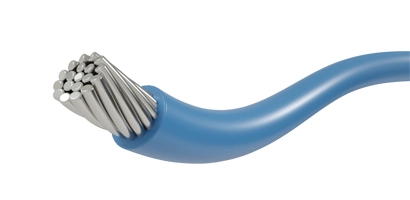Mil Spec wires and cables are designed to withstand the demanding conditions encountered in military operations, such as extreme temperatures, vibrations, moisture, and exposure to chemicals and fuels. They are engineered to ensure reliable performance and durability in harsh environments, making them essential components in military equipment and systems.

Operating Temperature: 260°C
Operating Voltage: 600V
Insulation: extruded PTFE
Approval: MIL-W-22759/ 9 / 10 / 11 / 12

Operating Temperature: -65°C to + 200°C
Operating Voltage: 600V
Insulation: extruded PTFE
Approval: ex. MIL-W-22759/ 5 / 6 / 7 / 8

Operating Temperature: 260°C
Operating Voltage: 600V
Insulation: extruded PTFE
Approval: ex. MIL-W-22759/ 5 / 6 / 7 / 8

Operating Temperature: -55°C to +260°C
Operating Voltage: 1000V
Insulation: extruded PTFE
Approval: MIL-W-22759/ 9 / 10 / 11 / 12

Operating Temperature: 150°C
Operating Voltage: 600V
Insulation: extruded ETFE
Approval: MIL-W-22759 / 16 / 17 / 18 / 19

Operating Temperature: -65°C to 150°C
Operating Voltage: 600V
Insulation: extruded ETFE
Approval: MIL-W-22759 / 16 / 17 / 18 / 19

Operating Temperature: 200°C
Operating Voltage: 1000V
Insulation: extruded PTFE
Approval: MIL-W-22759 / 20 / 21 / 22 / 23

Operating Temperature: 260°C
Operating Voltage: 1000V
Insulation: extruded PTFE
Approval: MIL-W-22759 / 20 / 21 / 22 / 23

Operating Temperature: -65°C to +150°C/200°C
Operating Voltage: 600V
Insulation: extruded FEP
Approval: NEMA HP4 Type K ex. MIL-W-16878/ 11

Operating Temperature: -65°C to +200°C/260°C
Operating Voltage: 600V
Insulation: extruded PTFE
Approval: NEMA HP3 Type E ex. MIL-W-16878/ 4 / 23 ex .18 awg & smaller dual rated to UL1180

Operating Temperature: -65°C to + 200°C/260°C
Operating Voltage: 1000V
Insulation: extruded PTFE
Approval: NEMA HP3 Type EE ex. MIL-W-16878/ 5 / 25 ; 18 awg & smaller dual rated to UL1180

Operating Temperature: -65°C to +200°C/260°C
Operating Voltage: 250V
Insulation: extruded PTFE
Approval: NEMA HP3 Type ET ex. MIL-W-16878/ 6 /27 ex. 18 awg & smaller dual rated to UL1180

Operating Temperature: -65°C to + 150°C/200°C
Operating Voltage: 1000V
Insulation: FEP
Approval: NEMA HP4 Type KK ex. MIL-W-16878/12

Operating Temperature: -55°C to +150°C/200°C
Operating Voltage: 250V
Insulation: extruded FEP
Approval: NEMA HP4 Type KT ex. MIL-W-16878/13

Operating Temperature: 150°C
Operating Voltage: 600V
Insulation: extruded ETFE
Approval: MIL-W-22759 / 16 / 17 / 18 / 19

Operating Temperature: 150°C
Operating Voltage: 600V
Insulation: extruded ETFE
Approval: MIL-W-22759 / 16 / 17 / 18 / 19
High-Quality Materials:
Mil-Spec wires and cables are manufactured using high-grade materials that meet strict military standards for performance and reliability.
Common materials include copper conductors, polyethylene (PE) or polyvinyl chloride (PVC) insulation, and ruggedized jackets for protection.
Durability and Environmental Resistance:
Mil-Spec wires and cables are designed to withstand harsh environmental conditions, including extreme temperatures, moisture, abrasion, and exposure to chemicals.
They are often specified to meet MIL-STD-810 environmental testing standards.
Electrical Performance:
Mil-Spec wires and cables must exhibit consistent electrical properties, including impedance, capacitance, and insulation resistance, to ensure reliable performance in critical military applications.
Safety and Reliability:
Mil-Spec standards prioritize safety and reliability, ensuring that wires and cables meet stringent requirements for fire resistance, low smoke emission, and resistance to mechanical stress.
Shielding and EMI Protection:
Many Mil-Spec wires and cables feature shielding to protect against electromagnetic interference (EMI) and radio frequency interference (RFI), which is critical for communication and electronic warfare systems.
Compliance with Military Standards (MIL-STD):
Mil-Spec wires and cables adhere to specific military standards and specifications outlined in documents such as MIL-DTL-22759 (aircraft wire) and MIL-DTL-24643 (shipboard cable).
These standards cover various aspects including construction, materials, testing methods, and performance requirements.
Aircraft Wire (MIL-DTL-22759):
Used in aerospace and aviation applications, including aircraft wiring harnesses and avionics systems.
Shipboard Cable (MIL-DTL-24643):
Designed for naval and maritime use, including shipboard electrical systems, communication networks, and propulsion systems.
Communication and Data Cables (MIL-C-17):
Used for military communication systems, radar installations, and satellite communications.
Power and Control Cables (MIL-DTL-24640):
Employed in military vehicles, ground equipment, and portable power distribution systems.
Interoperability and Compatibility:
Mil-Spec products ensure compatibility and interoperability across different military platforms and systems.
Proven Performance:
Mil-Spec wires and cables undergo rigorous testing and validation to demonstrate performance in demanding military environments.
Reliability in Critical Applications:
Military-grade components provide enhanced reliability and durability for mission-critical operations and equipment.
Standardization and Quality Assurance:
Mil-Spec standards promote consistency, quality assurance, and traceability throughout the supply chain.